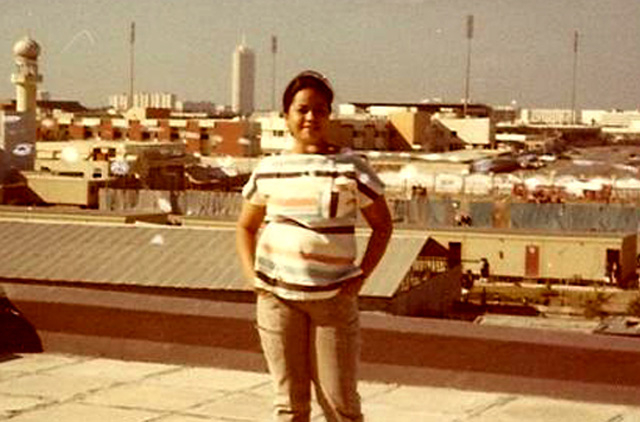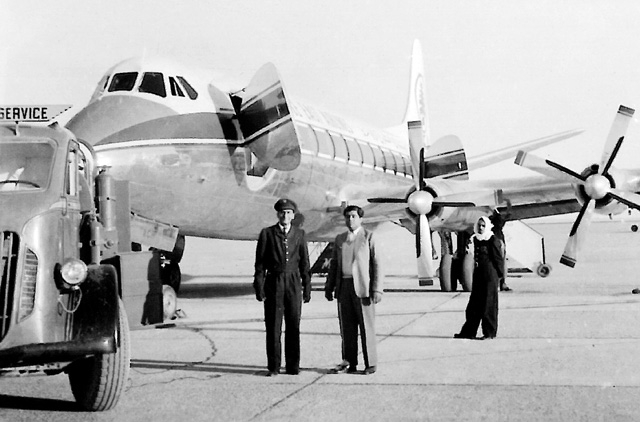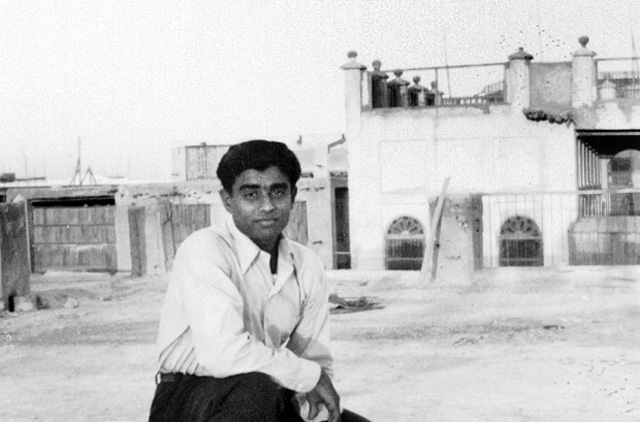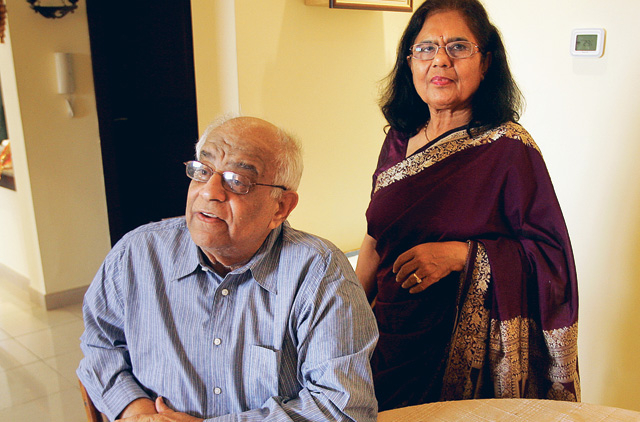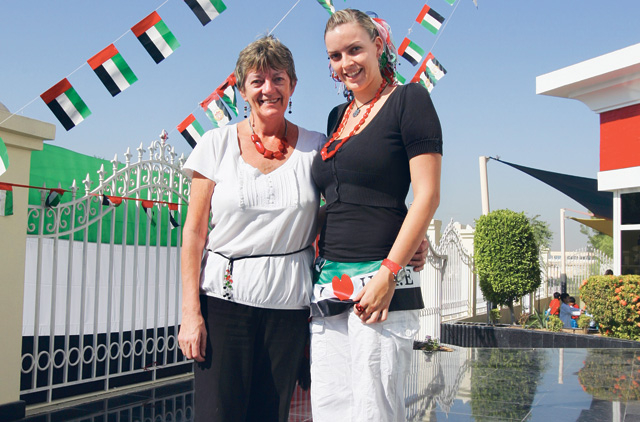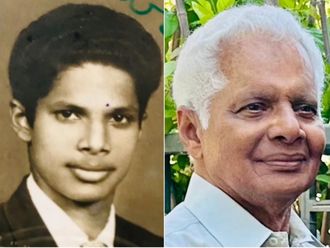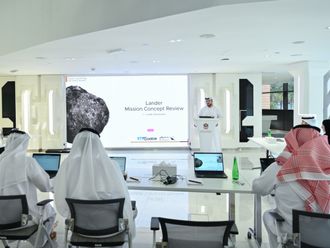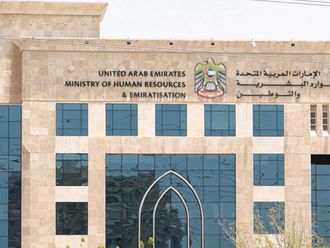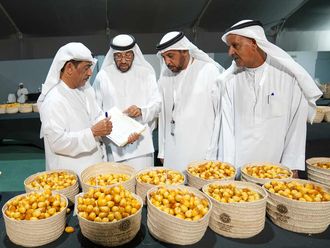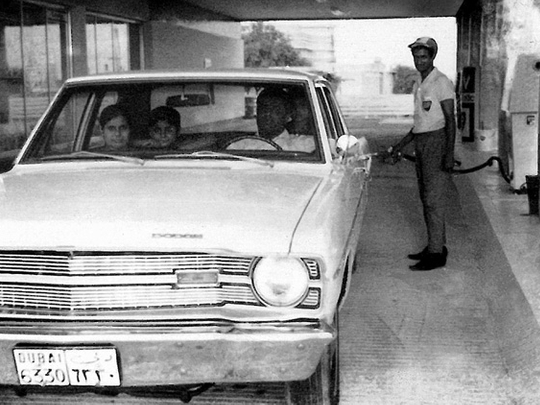
Aroona and Ghansham Asarpota (In the UAE since 1954)
It was 1954 and Aroona and Ghansham Asarpota had just landed in the UAE. Except that the UAE hadn't been formed yet.
The Asarpotas were transferred by British Petroleum from Bahrain to an area known as the Gulf Trucial States. "Back then, Dubai didn't exist. It was just desert with the Bur Dubai Creek in the middle of it. Sharjah was slightly more developed with a tiny landing strip and some compounds of makeshift homes for expats," recalls Aroona, who landed in Sharjah as a 15-year-old bride, two weeks after her wedding in Bahrain.
While Aroona was born and raised in Bahrain, her husband was born in Pakistan. At the time of the India-Pakistan partition in 1947, Ghansham and his family moved to Bahrain, where he stayed for the next seven years, until he moved with his new bride to the Trucial States.
"We landed in Sharjah nearly two decades before the birth of the UAE (see cover for photos)," says Aroona. "All around us was desert. There was no national currency, so everyone traded in the rupee, which is the Indian currency," she said.
Living in a desert land came with its own challenges. Aroona recalls how water was a scarcity, while petrol was freely available. "Houses were built differently than they are today. Naturally, there were no pipelines or taps, so water had to be bought from the merchants on a daily basis. It was limited to four gallons per person per day, and that included water for bathing, drinking, cooking, cleaning, and everything else. One day, while my husband was working, I realised the floors at home were really dirty and I'd run out of water for the day. All around me were barrels of petrol. At the time, I didn't know of the dangers of fuel. It looked like a clear liquid and I figured there was nothing wrong using it to mop the floors. When I look back now, I shudder to think of the danger I was putting my family in."
Six cars in trucial states
Ghansham recalls the days when travelling was primarily done by camel and donkey. "There were a total of six Land Rovers in the Trucial States, which were owned by the Bedouins to ferry people between the different states. We were fortunate to have one from British Petroleum. No other car would work since the land was all desert terrain. We used to drive into Deira and cross the Creek on an abra to reach Bur Dubai. The Maktoum family used to live there, and it was not uncommon to sit and have a chat with them on a regular basis."
Asarpota's wife says there were many times when she would see the late Shaikh Rashid pass her by and he would always be ready with a greeting and a smile for all. "In those days, we didn't think much of it. We would often go to the Shaikha's homes and chat with her too. Life was very different in the pre-UAE era."
The majority of the landmarks and monuments hadn't even been conceived in the early ‘50s. Two landmarks, however, remain standing nearly 60 years later: The Bur Dubai mosque and the adjacent temple.
"Although there wasn't a city yet, there were still people living here for trading and fishing purposes. Where there are people, there will be places of worship. Therefore the mosque and the temple were built and continue to be visited even today," says Aroona.
The couple, who now live with their children and grandchildren in a penthouse apartment in Dubai, continue to be amazed when driving down Shaikh Zayed Road, or New Dubai.
"All that land was barren desert just a few years ago. It never ceases to amaze us how quickly the city has grown. It seems like only yesterday that the UAE was first formed. It was December 2, 1971. How time flies. Here we are, 39 years later, and everything has changed. Dubai has grown by leaps and bounds. We can hardly believe this is the same city we came to 56 years ago," says Aroona.
Nigel Basford (In the UAE since 1977)
When Nigel Basford first landed in Dubai in 1977, it was a step up from his year in Nigeria. "It was still early days for the UAE, and at the time, Sharjah was the hub of all activity," he says. "Dubai was much quieter, it was still growing. Sharjah had already established itself and most Western expats chose to live there".
At the time, Basford had his wife and three daughters with him. "Most of the UAE was still barren land, and the few family clubs that existed were in Sharjah. My family and I were members of the Continental Club on the Sharjah Corniche (which is now Sharjah Ladies' Club), as well as the Lilly Club in Ajman."
Basford recalls taking his family to Dubai when Al Nasr Leisureland opened in 1978. "Finally, there was a play arena for my children, and restaurants for adults. Outside of that, Dubai had just one mall - The Al Ghurair Centre, which is where everyone went shopping."
Reminiscing about the years gone by, the 61-year-old Briton remembers how there were no cinemas in Dubai save the one at Galleria, near the Hyatt Regency in Deira. "However, the cinema only showed Bollywood movies. Most Western expats had to rely on renting Betamax tapes to watch Hollywood movies," he says.
"When I first got here, I was surprised to find out that all buildings and villas were air-conditioned. Electricity wasn't a problem obviously, as the country had already discovered oil. Although the Clock Tower and the Hyatt Regency existed, I've seen the bulk of the city being built before my eyes. Shindagha Tunnel didn't exist in the days I first landed. I watched it being built brick by brick. Port Rashid and the Dubai Dry Docks were also under construction in 1977," says Basford who admits to feeling national pride when he looks at the progress the UAE has made in the last 39 years.
Although the Briton has left the UAE for short periods of time over the last three decades, he always felt at home here. "I'm more at home here than I am in the UK," he says. "There's nowhere else in the world I'd rather be."
Gaynor Eastwood (In the UAE since 1979)
Gaynor Eastwood was a 24-year-old nurse in Wales when she read an advert in a newspaper that stated: "How Would You Like To Nurse In The Sun?"
"That was all the encouragement I needed," says the 57-year-old teacher. "By January of 1979, I was in Al Ain, working as a nurse in a local hospital."
However, since Sharjah was the most popular emirate for expats at the time, Eastwood soon moved base to Sharjah and started working at the Al Qasimi Hospital by 1980. "I've been privileged to spend my life here. I met my late husband Barry in Sharjah in 1982. We had a beautiful wedding party at the Sharjah Marina, which unfortunately doesn't exist any longer. My daughter Claire, now 24, has grown up here. She studied in Dubai and now works with me at the Star International School, Al Twar, as a teacher."
Eastwood smiles as she recalls the lack of infrastructure in Dubai in the early days. "What's most incredible is to see the transformation of Shaikh Zayed Road from a two-lane street to a six-lane highway," she says.
Back in the day, driving from Sharjah to Dubai didn't include the manic chaos of today. "There were hardly any cars and traffic was free-flowing. It took me barely 15 minutes to drive down from Sharjah to the World Trade Centre. Beyond that point, not much existed. Safa Park had been built, but it was like a little oasis in the middle of nowhere."
The Welsh teacher admits that for now, Dubai is home. "The fact that three decades later I'm still here says a lot about how I feel about Dubai. It's a city that's given me so much love, laughter and happiness. At this point in my life, it's home."
Pat Castro and Shirley (In the UAE since 1979/1980)
When Pat Castro arrived in Dubai on July 3, 1979 at the age 23, it was baking hot and he didn't think he would survive a day.
Thirty-one years later the 54-year-old from the Philippines looks back with nostalgia on his life from the day he joined as a chef at the Dubai International Hotel (now Le Meridien Airport). "The sun was baking the ground when I first came out of the aircraft. I wondered ‘how long I could stay here?' There were frequent sandstorms. Dubai was virtually a desert outside Deira and Bur Dubai. The Dubai Airport looked very basic."
While working at the hotel, he met his wife Shirley, 52, who arrived in Dubai in April 1980 to work as a midwife for Rashid Hospital. The couple got married in 1984. Pat then moved to Dubai Police as a supervisor and worked there for 20 years until 2004, while Shirley moved to Al Wasl Hospital in 1987. Last year, the Castros celebrated their 25 years in Dubai, having spent more than half of their lives in the UAE.
Their three daughters were all born and raised in Dubai - Sheila, 24, Sarah, 23, and Sharlyn Joy, 16.
Shirley said: "The difference that three decades made just shows that, with good leadership, something like the UAE is possible."
Pat, who has since moved into the travel agency business, quit his job following a delicate laparotomy operation in March at the Rashid Hospital to treat a lingering digestive track problem.
"It won't be long before this becomes a medical hub, too," said Pat, who hopes to work until he reaches 60, before retiring to a district in Manila - at a place he has rarely seen for most of his adult life.
With inputs from Jay B. Hilotin, Chief Reporter


